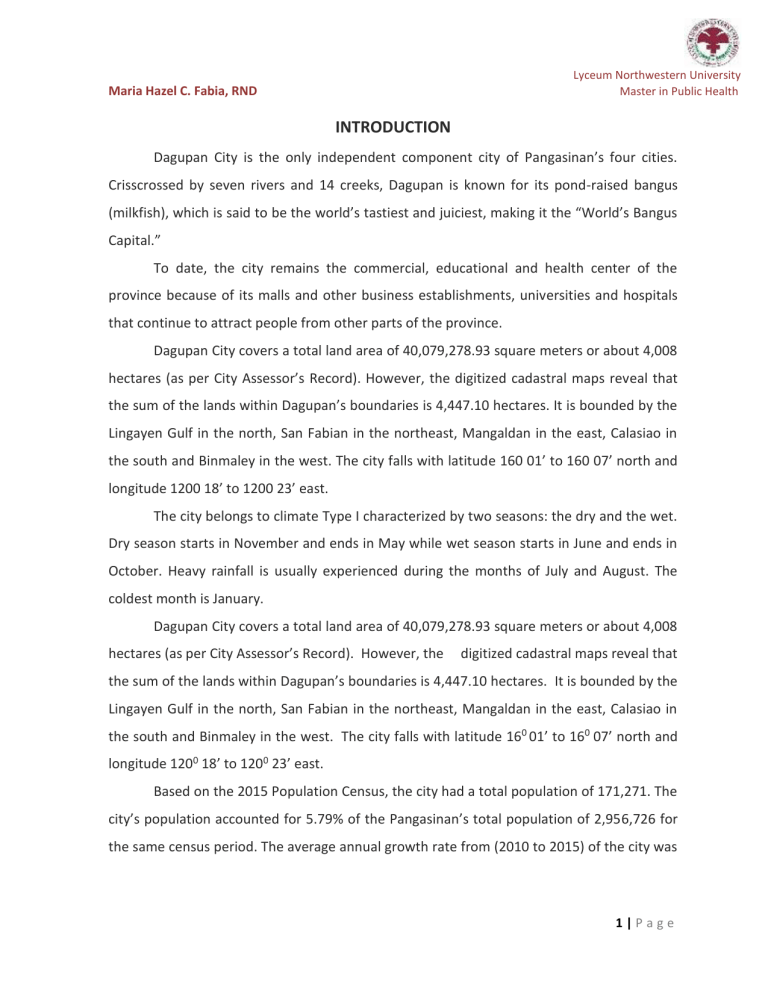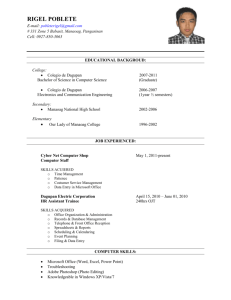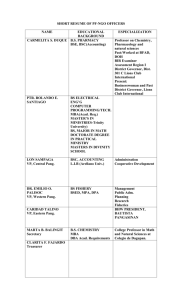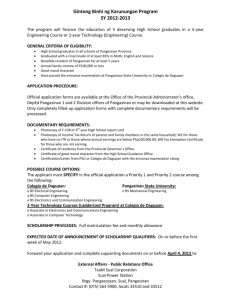
Lyceum Northwestern University Master in Public Health Maria Hazel C. Fabia, RND INTRODUCTION Dagupan City is the only independent component city of Pangasinan’s four cities. Crisscrossed by seven rivers and 14 creeks, Dagupan is known for its pond-raised bangus (milkfish), which is said to be the world’s tastiest and juiciest, making it the “World’s Bangus Capital.” To date, the city remains the commercial, educational and health center of the province because of its malls and other business establishments, universities and hospitals that continue to attract people from other parts of the province. Dagupan City covers a total land area of 40,079,278.93 square meters or about 4,008 hectares (as per City Assessor’s Record). However, the digitized cadastral maps reveal that the sum of the lands within Dagupan’s boundaries is 4,447.10 hectares. It is bounded by the Lingayen Gulf in the north, San Fabian in the northeast, Mangaldan in the east, Calasiao in the south and Binmaley in the west. The city falls with latitude 160 01’ to 160 07’ north and longitude 1200 18’ to 1200 23’ east. The city belongs to climate Type I characterized by two seasons: the dry and the wet. Dry season starts in November and ends in May while wet season starts in June and ends in October. Heavy rainfall is usually experienced during the months of July and August. The coldest month is January. Dagupan City covers a total land area of 40,079,278.93 square meters or about 4,008 hectares (as per City Assessor’s Record). However, the digitized cadastral maps reveal that the sum of the lands within Dagupan’s boundaries is 4,447.10 hectares. It is bounded by the Lingayen Gulf in the north, San Fabian in the northeast, Mangaldan in the east, Calasiao in the south and Binmaley in the west. The city falls with latitude 160 01’ to 160 07’ north and longitude 1200 18’ to 1200 23’ east. Based on the 2015 Population Census, the city had a total population of 171,271. The city’s population accounted for 5.79% of the Pangasinan’s total population of 2,956,726 for the same census period. The average annual growth rate from (2010 to 2015) of the city was 1|Page Maria Hazel C. Fabia, RND Lyceum Northwestern University Master in Public Health 0.87% and having a population density of 3,851 person/square kilometer. As of 2017, Dagupan had a projected population of 174,264. Dagupan City has the highest population density in the Ilocos Region. Based on the 2015 Census of Population, Dagupan City has 4,600 persons per square kilometer. It is followed by neighboring Mangaldan with a population density of 2,207 and Vigan City in Ilocos Sur, which had 2,145 persons per square kilometer. Of the 3,265 barangays in the Ilocos Region, the largest in terms of population is Barangay Bonuan Gueset in Dagupan City, with its population of 23,373 in 2015. It was followed by Barangay Pantal (17,841) and Barangay Bonuan Boquig (14,354). Also in the top ten most populous barangays in the region is Barangay Lucao (10,252), which landed in the 8th place. Official Seal The current Dagupan seal was derived from a 2011 logo design competition, which was participated in by eligible residents of the city. The winning seal design, which was unveiled on May 2011, was conceptualized by Carmelo John E. Vidal. The four previous elements (a horseshoe magnet, a railway, a road, and a ribbon bearing the words “Sigue Dagupan”) of the 1948 seal was added upon. Among the new symbols integrated in the seal are: a milkfish, 31 stars which signifies the constituent barangays of the city; seven wave crests which represents the city’s rivers, a torch which signifies education, and a gear which represents commerce. On December 9, 2012, former Mayor Benjamin S. Lim received the certificate of registration for this city’s new corporate seal (Republic Act 7160). 2|Page Maria Hazel C. Fabia, RND Lyceum Northwestern University Master in Public Health VISION: Dagupan City as the premier center for commerce and aquaculture in North Luzon supported by a viable solid waste management system and a disaster resilient environment. A city that every Dagupeño can be proud of. MISSION: To improve the life of every Dagupeño by living the value of ‘our city, our shared responsibility’. VALUES: D isplina A ngat na Serbisyo G aling at Talino U galing Matapat P ananagutan sa Lahat ng Gawi A tensyong Makabayan N agkakaisa sa Iisang Pangarap INFRASTRUCTURE / FACILITIES A. Road Line Network Transportation: (CY 2018) Number of Registered Motor Vehicles 49,971 Number of Bus Companies 7 1. Victory Liner 2. Dagupan Bus 3. Five Star 4. Solid North Transit Inc. 5. Mhelbhen Group of Operators 6. First North Luzon 7. Boltex Express B. Telecommunications: (CY 2018) Telegraph/Money Express Padala Stations: 25 Number of Internet Service Providers: 6 Number of Telephone/Cellular Companies: 4 Number of Internet Café: 67 Number of Cable Service Providers: 4 Number of TV Broadcasting Stations: 3 Number of Radio Broadcasting Stations: 13 Number of Local Periodicals :10 3|Page Maria Hazel C. Fabia, RND Lyceum Northwestern University Master in Public Health C. Postal Communications: Post Office (main): 1 Satellite Post Office: 3 Municipalities Served (%): 100% Number of Letter Carriers: 14 Number of Barangays served by letter carriers: 2-3 barangays/letter carrier D. Water Supply: The Dagupan City Water District (DCWD) supplies the water needs of city populace except in Barangay Carael where the water system is managed by a locally formed association, the Carael Water Works Association (CAWA). Household served by potable water (%): 97% No. of pumping station: 20 Number of Water Refilling Station: 84 E. Power/Electrification: The power requirement of Dagupan City is provided mainly by the Dagupan Electric Corporation (DECORP). Barangays Served (%): 100.00% Household Served (%): 95.63% 4|Page Lyceum Northwestern University Master in Public Health Maria Hazel C. Fabia, RND HISTORY A BIT OF HISTORY The early settlers of Dagupan City are believed to have come from Flores Islands in Indonesia because of their dialect which has a strong similarity to the Pangasinan dialect. Their main occupation is fishing and salt making, a major source of income among coastal residents of today. Originally named Bacnotan by the Augustinian missionaries a few years after the establishment of the Spanish encomienda in Pangasinan in 1583, Dagupan was already known to be the biggest entreport (marketplace) not only in the province of Pangasinan but the whole of Region I. In 1660, Andres Malong, a local chieftain, led a revolt against the Spaniards for imposing forced labor. After the revolt, the people rebuilt the town. To commemorate the gathering forces under Malong, the place was renamed to “Nandaragupan,” which means, “Where people meet.” In 1780, the name of the town was simplified to Dagupan, followed by the end of Spanish rule on July 23, 1898, when the Spanish troops surrendered to the Katipunan leader, General Francisco Makabulos. The 45th Infantry Batallion under Gen. Douglas MacArthur landed at the shores of Bonuan, then later totally liberated Dagupan from the Spanish rule. The first civil government was established on February 16, 1901 with the holding of the first elections through “viva voce.” Early on, Dagupan was already the seat of education in the region. 5|Page Lyceum Northwestern University Master in Public Health Maria Hazel C. Fabia, RND Following the fall of Bataan, the Japanese Army invaded Dagupan. Japanese rule lasted until 1945. On June 20, 1947, two years after the liberation, Dagupan became a city by virtue of Republic Act 170, a law known as the City Charter of Dagupan. This charter governs the operations of the city as an independent political entity with its own distinct zeal. SOCIAL SERVICES (EDUCATION, HEALTH & NUTRITION) 1. EDUCATION Number of Schools: SY 2018-2019 Schools Public Kindergarten 34 Elementary 34 Junior H.S. 8 Senior H.S. 8 Tertiary Universities Colleges Vocational Schools Private 27 28 23 24 Total 61 62 31 32 12 3 9 24 Enrollment SY 2018 – 2019: Kindergarten Elementary Junior H.S. Senior H.S. Male (Public) Female (Public) Both Sexes (Public) Male (Private) Female (Private) Both Sexes (Private) 1,614 9,865 6,136 1,578 1,481 8,831 6,177 1,630 3,095 18,696 12,313 3,208 446 2,260 2,153 3,559 424 2,047 2,217 4,381 870 4,307 4,370 7,940 Education Indicators SY 2017-2018: INDICATOR Participation Rate Cohort-survival Rate Promotion Rate Transition Rate Retention Rate Repetition Rate Drop Out Rate Gross Enrolment Rate School Leaver Rate ELEMENTARY 93.53% 98.41% 96.66% 98.90% 99.03% 2.89% 0.29% 101.66% 0.38% SECONDARY 94.55% 89.05% 92.50% 100.54% 96.09% 20.02% 0.75% 114.20% 2.79% 6|Page Lyceum Northwestern University Master in Public Health Maria Hazel C. Fabia, RND 2. HEALTH Health Statistics: (CY – 2018) Total Number of Live Birth: 2,670 Crude Birth Rate: 15.06 live births /1000 population Total Number of Death: 1,122 Crude Death Rate: 6.33 deaths/1000 population Total Infant Death: 40 Infant Mortality Rate :14.98/1000 live births Total Maternal Death :1 Maternal Mortality Rate: 37.45/1000 live births (60/100,000live births) Under Five Deaths: 56 Under 5 Mortality Rate: 20.97/1000 live births Ten Leading Causes of Morbidity CAUSES OF MORBIDITY Acute Respiratory Infection Skin Diseases Animal Bite Hypertension Bronchial Asthma/Bronchitis Urinary Tract Infection Punctured/Lacerated Wound Diarrheal Diseases/ Acute Gastroenteritis Arthritis Diabetes Mellitus Leading Causes of Mortality CAUSES OF MORTALITY Hypertension Cancer All Forms Pneumonia Diabetes Mellitus Myocardial Infarction Accident All Forms Degenerative Disease of Elderly/ Senility Cerebrovascular Diseases/ Accident Kidney/ Renal Diseases Bronchial Asthma MALE 7,380 1,884 1,922 1,389 801 388 826 513 FEMALE 9,151 2,310 1,995 2,441 774 1,011 549 531 267 303 TOTAL 16,531 3,917 3,917 3,830 1,575 1,399 1,375 1,044 632 545 RATE 93.27% 23.66% 22.10% 21.61% 88.86% 78.93% 77.58% 59.00% 899 848 50.72% 47.84% MALE 89 65 66 52 53 51 29 FEMALE 58 72 47 57 33 13 30 TOTAL 147 137 113 109 86 64 59 RATE 82.94% 77.30% 63.75% 61.50% 48.52% 36.11% 33.28% 31 26 57 32.16% 26 20 18 16 44 36 24.82% 20.31% 7|Page Lyceum Northwestern University Master in Public Health Maria Hazel C. Fabia, RND Leading Causes of Infant Mortality INFANT MORTALITY Aspiration Pneumonia Prematurity Pneumonia Sepsis Neonatrum Severe Dehydration Leading Causes of Under 5 Mortality CAUSES OF UNDER 5 MORTALITY Pneumonia Aspiration Pneumonia Prematurity Sepsis Neonatrum Congenital Heart Diseases Health Facilities (CY 2018) HEALTH FACILITIES Number of Hospitals Bed Capacity 8 6 6 4 2 (29.96) (22.47) (22.47) (14.98) (14.90) TOTAL 9 8 6 4 4 PUBLIC 1 600 PRIVATE 11 549 Environmental Household with access to improve or safe water supply PERCENT 33.70% 29.96% 22.47% 14.98% 14.98% TOTAL 12 1,149 34,413 96.96% 32,661 33,560 32,208 92.03% 94.56% 90.75% Level I Level II Level III Household with sanitary toilet facilities Household with satisfactory disposal or solid waste Household with sanitary facilities 8|Page Lyceum Northwestern University Master in Public Health Maria Hazel C. Fabia, RND 3. NUTRITION Nutrition Status: Pre-School Children (OPT 2018) NUTRITION MALE Normal 11,101 Underweight 226 Severely Underweight 127 Overweight 74 Total Pre-School Weighed 21,642 FEMALE 10,541 185 127 70 10,923 NUMBER 21,642 411 254 144 22,451 Nutritional Status Report of Elementary School Children BASELINE July (SY 2018-2019) NUTRITION MALE FEMALE NUMBER Severely Wasted 655 506 1,161 Wasted 1,266 1,073 2,339 Overweight 545 340 885 Obese 197 61 258 Normal 8,744 8,253 16,997 Total Pupil Weighed 11,407 10,233 21,640 Public Secondary Students BASELINE July (SY 2017-2018) NUTRITION MALE Severely Wasted 284 Wasted 795 Overweight 218 Obese 29 Normal 5,794 Total Pupil Weighed 7,120 FEMALE 147 522 157 22 6,387 7,235 NUMBER 431 1,317 375 51 12,181 14,355 PERCENT 96.40% 1.83% 1.13% 0.64% 100.00% PERCENT 5.37% 10.81% 4.09% 0.60% 78.54% 100.00% PERCENT 3.00% 9.17% 2.61% 0.36% 84.86% 100.00% 9|Page Maria Hazel C. Fabia, RND Lyceum Northwestern University Master in Public Health 4. FAMILY PLANNING (CY 2018) A. Pre-Marriage Counseling: • Regular: 713 couples • Special: 107 couples B. No. of Inter-racial Wedding: 5 couples Mother’s Class and KATROPA: 3,856 participants Adolescent Health & Youth: 10 schools (2,866 participants) 5. SOCIAL WELFARE (CY 2018) Number of Staff: 41 Social Worker: 6 Non-Social Worker: 35 CSWDO Plantilla/Detailed: 11 Job Order Employees: 24 Number of Day Care Workers: 46 Number of Day Care Centers: 46 Number of Pre-School Served: 2,589 Number of Clientele Served: 28,269 • CICL: 48 • CNSP: 37 • Other Children In Need: 57 • Youth: 1,915 • Women: 2,135 • Families: 14,700 • Solo Parents: 237 • 4Ps: 4,192 • Persons with Disability: 979 • Senior Citizens: 3,969 10 | P a g e Lyceum Northwestern University Master in Public Health Maria Hazel C. Fabia, RND OBJECTIVES 1. To assess and evaluate if the said City meets the standard provisions of the Sanitation Code of the Philippines and observe the environmental factors that affect health. 2. Assess health impacts of various elements of environmental sanitation; 3. Assess effectiveness of existing environmental sanitation programmes; 4. Assess the health and socioeconomic benefits of environmental sanitation interventions on the basis of preventable burden of disease and their cost-effectiveness; 5. Identify efficient interventions; 6. Identify research and development needs; 7. Identify high risk groups; 8. Direct interventions to groups most in need. METHODOLOGY The visit was conducted for data collection at the Sanitation Office, City Health Office, Dagupan City which involves direct interview with the center head, Ms. Marcelina C. Gorospe. Limited amount of time was given due to the current situation we are facing nowadays. CONCLUSION Environmental sanitation strongly depends on social and cultural practices and beliefs and these have to be considered when planning interventions. To allow for transmission of infectious agents they have to be present in the immediate human environment, exposure has to take place, and transmission has to occur by uptake of the agents through unsafe practices. To interrupt the transmission, environmental sanitation can act on reducing exposure to infectious agents by limiting contact to wastes or polluted media, and by changing hygiene and socio-cultural practices. 11 | P a g e Maria Hazel C. Fabia, RND Lyceum Northwestern University Master in Public Health The main problems seem to be related to the insufficient awareness of people living in unsanitary conditions and of their national and local authorities, and the costs of implementation, operation and maintenance of the systems. The costs of environmental sanitation, if considered as the investment and operational costs of sanitary installations and the costs of hygiene education may seem high. There are, however, benefits that may not seem evident at first sight. The costs of inadequate sanitation may lead to direct economic loss due to disablement of ill people that cannot perform their work, the loss of education of disabled school children, and the creation of a polluted environment impacting on economic activities (e.g. fisheries, tourism). In addition it increases health care costs. As this problem is relatively far reaching, involving numerous social and economic factors, it is difficult to assess at a global scale. HAZARD AND VULNERABILITY PROFILE OF DAGUPAN CITY 1. Earthquake - There are two factors why Dagupan City is very vulnerable to geological hazards particularly on earthquakes. One is due to the regional setting where large areas are bound to be affected by high-magnitude earthquakes. The other reason is due to the local setting where shaking forces may be amplified. The major earthquake that hit the City was on July 16, 1990. The earthquake caused a decrease in the elevation of the city and several areas were flooded. The city suffered 64 casualties of which 47 survived and 17 died. Most injuries were sustained during stampedes at a university building and a theater. 2. Flooding- The poor elevation of the City makes it more vulnerable to flooding. Moreover, this geological characteristic of Dagupan is the reason why the City is the catch basin of flood waters from the neighboring towns. 12 | P a g e Lyceum Northwestern University Master in Public Health Maria Hazel C. Fabia, RND 3. Cyclone- In the vicinity of Dagupan City, the typhoon passage frequency is about 5 cyclones each year. One of the recent most noted typhoons that hit the City was typhoon Pepeng which brought massive flooding and infrastructure damages in the City. 4. Tsunami and Storm Surge- Although there is no reported tsunami or storm surge that devastated the City, these hazards must be considered as well because Dagupan is a coastal city which makes it very vulnerable to such calamities. RECOMMENDATION 1. Sanitation needs to be addressed as a whole, including improvement of facilities, environmental conditions and behavioral change. 2. Sanitation programs should be demand-based and the community should be fully involved in the process. 3. Sanitation should be a component of other health-promoting or disease control programs. 4. Awareness needs to be raised and sanitation set as a priority in national and local governments, and also in the population at large 5. Systems have to be sustainable; cost-sharing and cost-recovery need to be addressed carefully; 13 | P a g e Maria Hazel C. Fabia, RND Lyceum Northwestern University Master in Public Health 14 | P a g e Lyceum Northwestern University Master in Public Health Maria Hazel C. Fabia, RND PROTOCOL L ETTER 15 | P a g e Lyceum Northwestern University Master in Public Health Maria Hazel C. Fabia, RND DAGUPAN CITY HEALTH OFFICE 16 | P a g e




